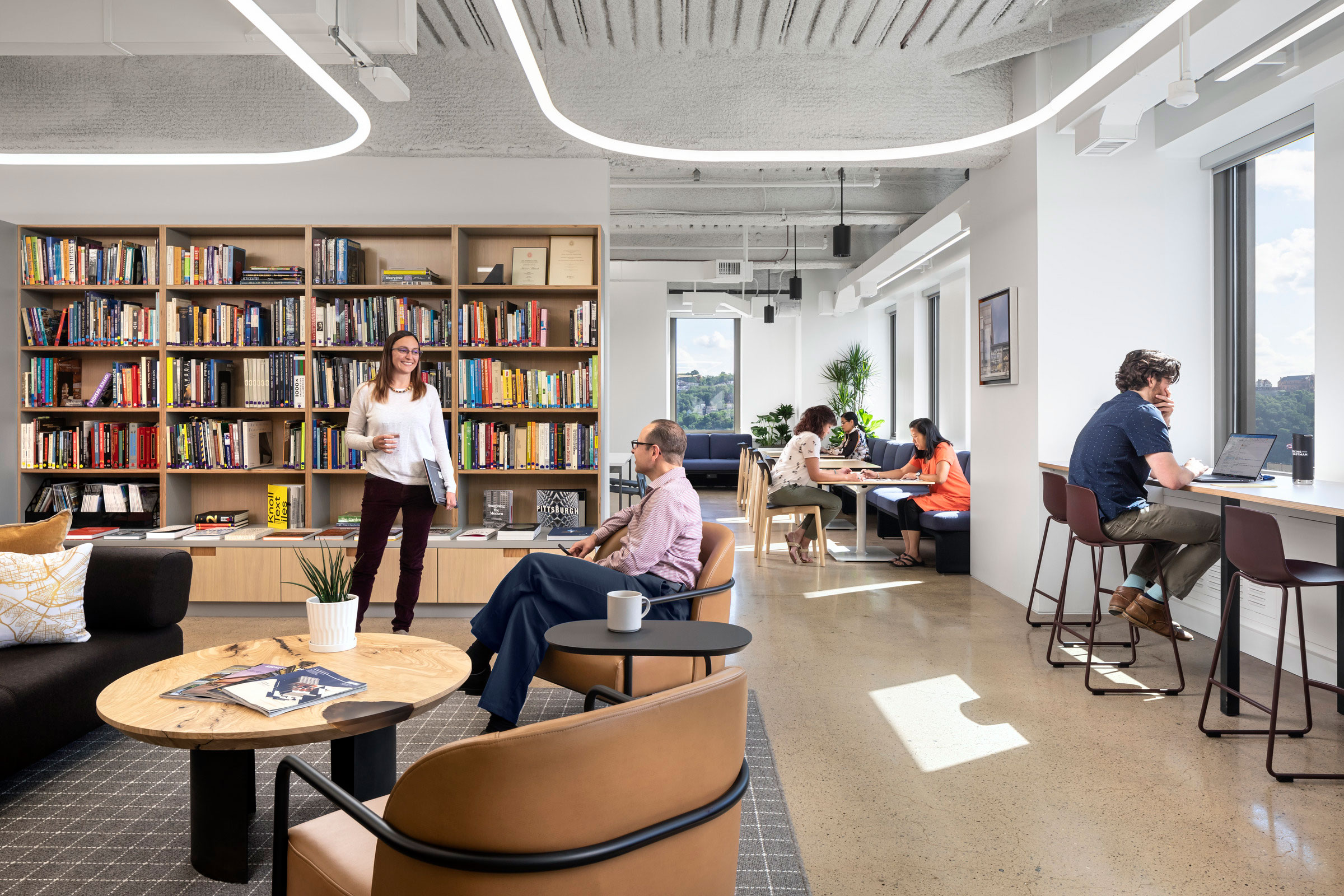Story at a glance:
- LEED certification is a globally recognized symbol of sustainability achievement and the most widely used green building rating system.
- LEED-certified buildings are cost effective when it comes to savings in energy, water, maintenance, and waste.
- As LEED-certified buildings become more standardized, corporations and cities are aiming toward higher certifications like Gold and Platinum.
With the passage of the Build Back Better Act in August 2022, we’re moving toward a future where sustainability may become a standard part of design conversations. But the groundwork for green building was long ago laid by USGBC and its LEED certification program.
But what is LEED, exactly? Explore gb&d’s guide to LEED as well as some great examples of newly certified LEED Gold builds.
LEED Certification Requirements
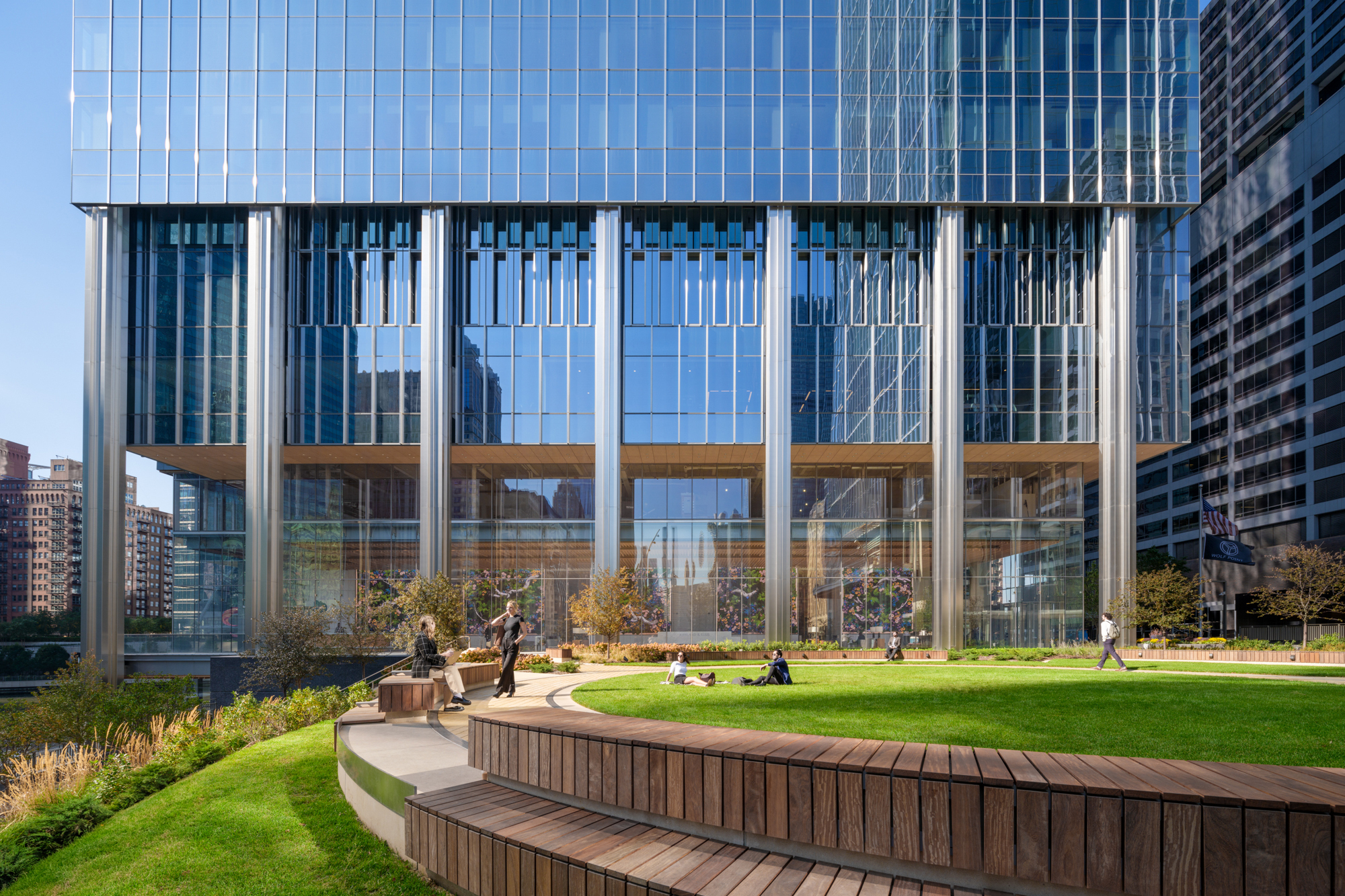
For a project like Salesforce Tower Chicago to earn LEED Gold certification, it must meet all relevant prerequisites and earn between 60 and 79 credit points. Photo by Jason O’Rear
LEED provides a sustainability framework to encourage buildings and cities to adhere to energy-efficient and cost-saving standards that help to reduce the overall contribution to global climate change while improving people’s lives. Started in 1998, LEED certification has become the most recognizable symbol of sustainability achievement across the globe, making it the most widely used green building system today.
But LEED doesn’t just help to make buildings greener. LEED-certified buildings have also been proven to save money when it comes to energy, water, maintenance, and waste. To be considered for certification, applicants have to register and pay a few fees. Once approved the applicant must identify the credits, or points, that the project aims to achieve. These points are assigned to areas of the project that address sustainable sites, energy, water, waste, transportation, materials, health, and indoor environmental quality. With 110 possible points to score, projects can achieve four possible LEED certification levels:
- Certified (40 to 49 points)
- Silver (50 to 59 points)
- Gold (60 to 79 points), and
- Platinum (80+ points).
As of February 2024 more than 111,857 projects worldwide have achieved some level of LEED certification.
15 LEED Gold Builds
LEED certification has become a standard in today’s market, with registration growing at an average of 20% for the past five years, and more than 8,800 additional projects registered since the beginning of 2022. This has pushed many cities and corporations to aim for higher levels to maximize their savings.
Here are 15 projects that have achieved LEED Gold.
1. UChicago Child Development Center Stony Island, Chicago
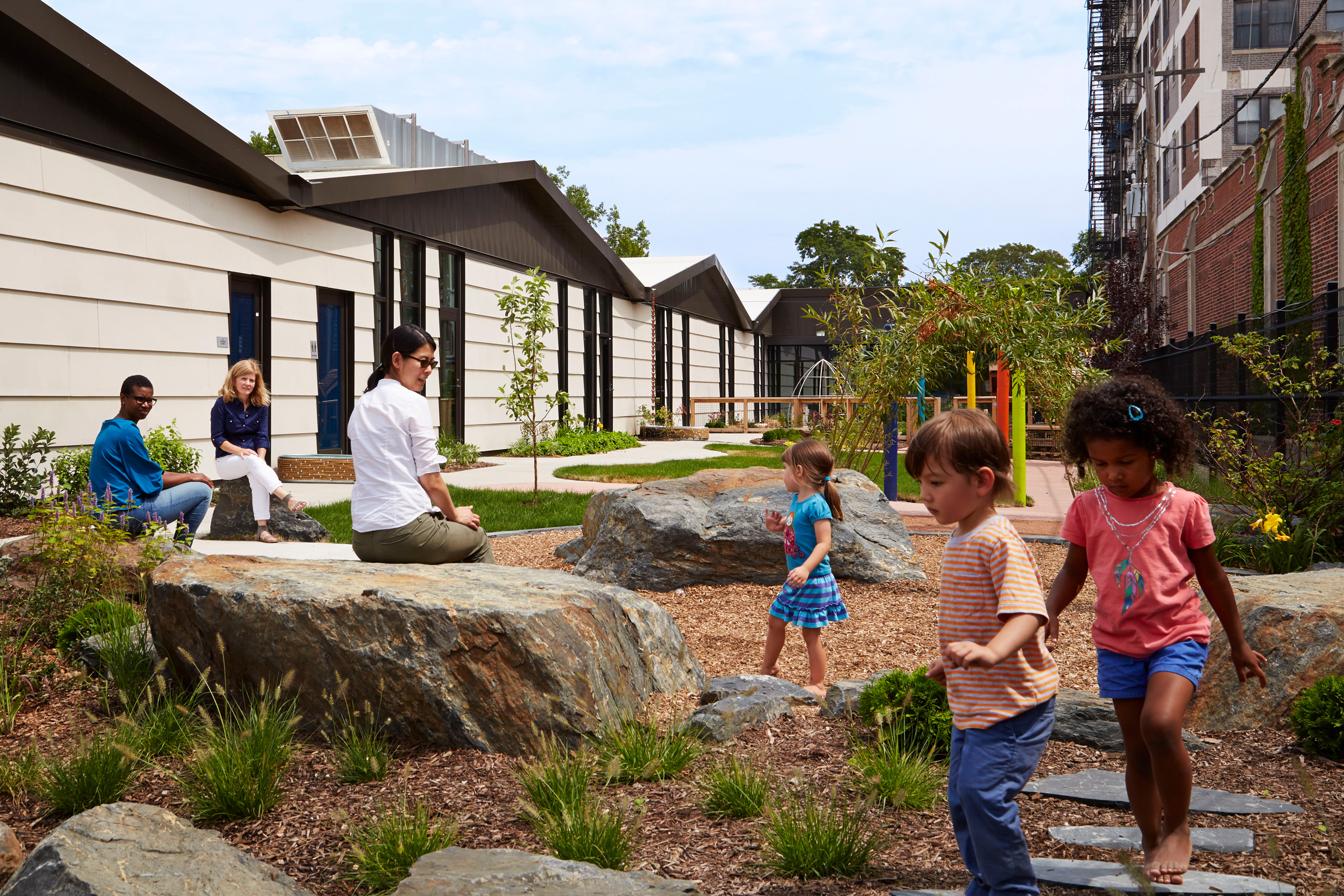
The LEED Gold-certified UChicago Child Development Center’s outdoor spaces can accommodate more than 100 children at the same time. Photo by Steve HallPhoto by Steve Hall
Designed by Wheeler Kearns Architects, the UChicago Child Development Center Stony Island is a green oasis in the otherwise largely urban Hyde Park neighborhood. Completed in 2013 the LEED Gold-certified building draws inspiration from nearby Jackson Park and puts sustainability at the forefront of its design.
The 13,000-square-foot Z-shaped building emphasizes natural lighting and sports a visible green roof across its eastern half. Aside from improving the site’s biodiversity and providing natural cooling, the green roof also helps to collect and divert stormwater into splash tanks—elements that, when combined with the project’s use of permeable pavement, greatly reduce the risk of urban flooding.
Biophilic design elements can be found throughout the project, particularly when it comes to material choices. Poplar Bark House® siding from Highland Craftsmen—a North Carolina-based finishing materials supplier—for example, lines the interior and exterior of the center’s east wing, providing a richly-textured natural surface that begs to be touched. “Touch is perhaps the most important stand-alone characteristic about the product,” Chris McCurry, Highland Craftsmen cofounder, previously told gb&d. “People want to touch it all the time—and are touched by it.”
Outside, large courts—dotted with impressive boulders extracted from glacial till—provide space for all of the center’s 124 children to play at the same time, while the playground equipment itself is designed to be both engaging and facilitate learning. “All these elements in the play area encourage the interrogation of the natural world, from the child’s point of view,” Larry Kearns, principal of Wheeler Kearns Architects, told gb&d in a previous article.
2. UC Davis Health Admin Building, Rancho Cordova, CA
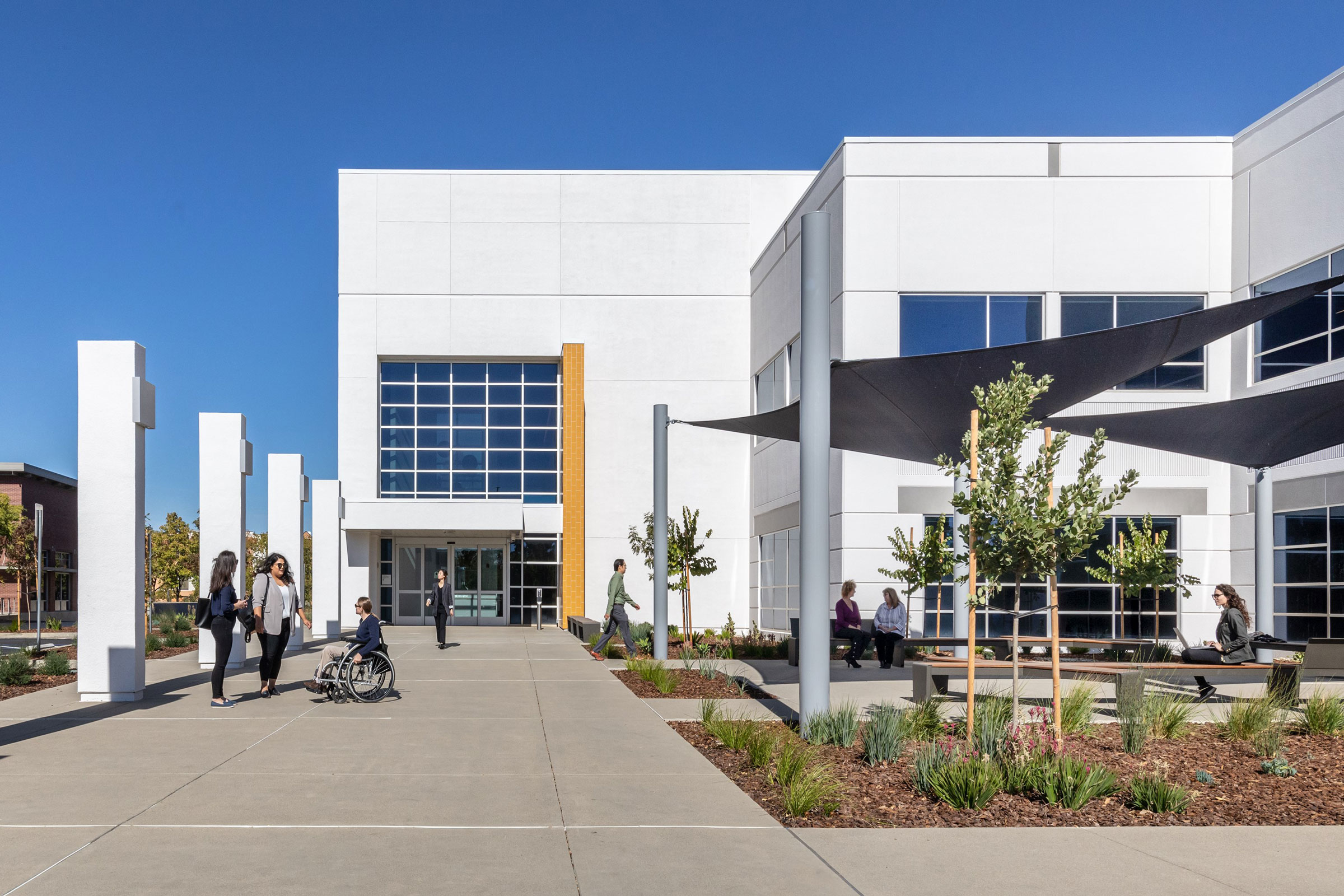
The all-electric UC Davis Health Admin Building project designed by Stantec allowed for a 58% reduction in embodied carbon as reuse versus a new build. The design was 31% more efficient than a standard ASHRAE baseline building. Photo by Kat Alves
Redesigned by Stantec to meet LEED Gold certification and the University of California’s Carbon Neutrality Initiative standards, the UC Davis Admin Health Building is an inspiring example of both adaptive reuse and modern biophilic design.
Originally built in the 1990s as a call center, the building was largely bereft of natural light and provided few open spaces for employees to socialize or gather. To remedy the daylighting issue, Stantec added new light wells and selected bright, neutral colors to help draw light into the interior. Outdoor patios and green spaces now provide employees with places to conduct informal meetings, work independently, or take a break from work and enjoy the fresh air, offering views of nature from every direction.
“This building is surrounded on three sides by mature trees. While this is a more of a suburban setting, you can see from the cafeteria, we allow for views to this greenery,” Brian Crilly, design principal at Stantec, previously told gb&d. “That’s very important from the standpoint of human health, and that gets back to the textures and colors we’re using as well—a little bit more natural and not just white everywhere.”
Hanging and wall-mounted greenery provide pops of color throughout the interior while wood and wood-like textures—amongst other high-quality tactile material choices—serve as subtle reminders of the natural world. “We’re not designing based on fad. It’s a variation of patterns and textures, it’s access to daylight, and it’s the celebration of shadows,” Crilly says. “It’s timeless in the sense that it’s based in nature.”
3. Salesforce Tower, Chicago
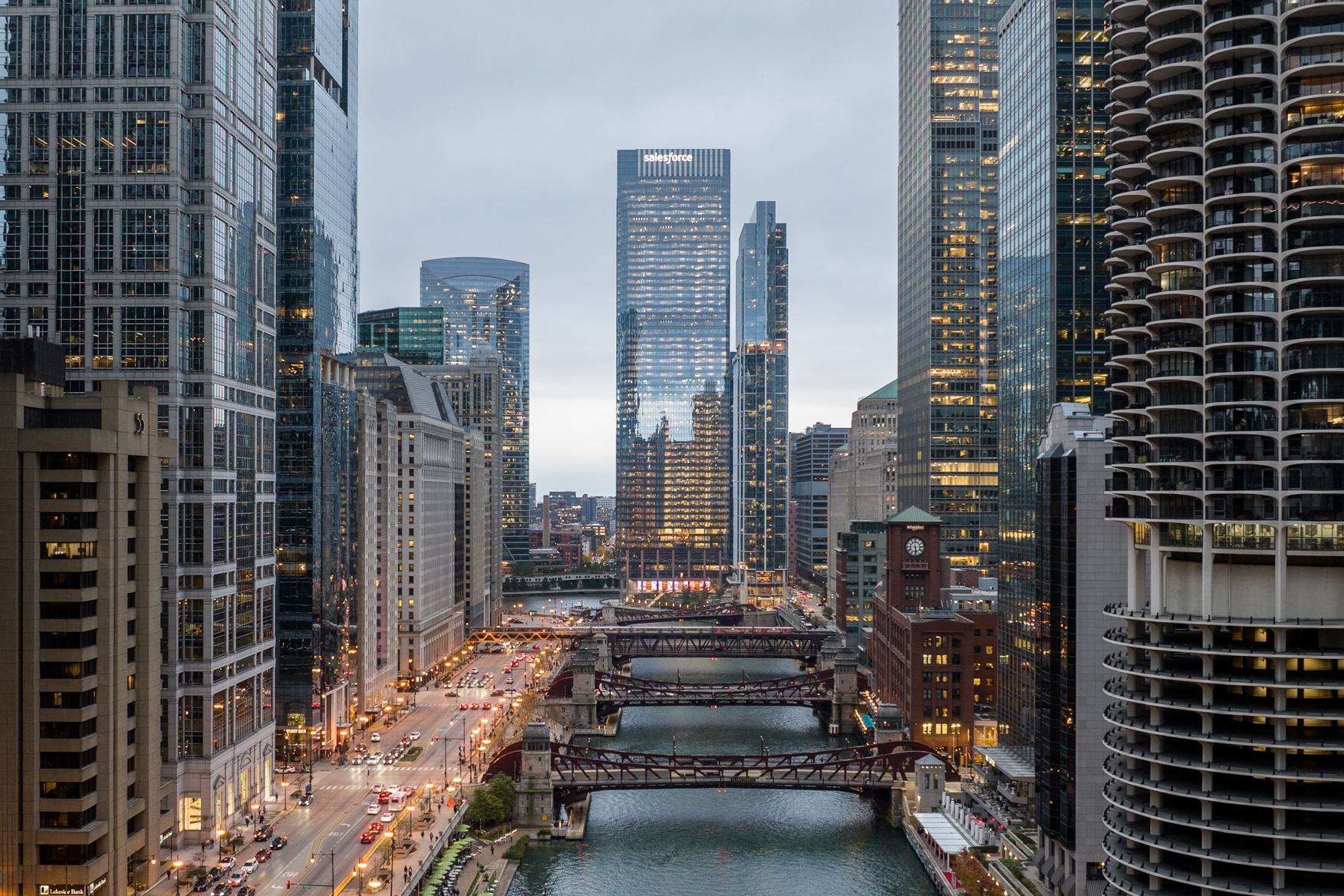
Green space, kayaking, and biking are all accessible from the new Salesforce Tower in Chicago. Photo by Jason O’Rear
Designed by Pelli Clarke & Partners, the recently-completed Salesforce Tower in Chicago is a monumental contribution to the Windy City’s ever-increasing portfolio of green, LEED-certified buildings.
Conceptualized as part office, part park, Salesforce Tower is located at the confluence of the Chicago River’s three branches and includes both roof terrace and ground level outdoor green spaces. The building also provides employees with direct access to the Riverwalk, a 1.25-mile pedestrian and bike path that offers expansive views of the river and opportunities for physical activity. “People want to get out and have fresh air. They want to get a sense of the seasons, the time of day. They want to exercise,” Darin Cook, partner at Pelli Clarke & Partners, previously told gb&d.
Clad in insulated floor-to-ceiling glass from Viracon, the tower maximizes views and daylight admittance while still maintaining a high level of energy efficiency and indoor thermal comfort. A folding glass wall high on the tower also allows occupants to enjoy the benefits of fresh air and natural ventilation on fair-weather days.
Nature is further invoked throughout the building’s interior via wood details and art to create a warm, welcoming environment grounded in local ecologies. Vertical, rolling strips of eucalyptus accents—inspired by the nearby Chicago River—adorn the end wall of each elevator lobby while a large art installation in the main lobby cycles through landscape photographs and biophilic-inspired digital artwork throughout the day.
4. 799 Broadway, New York City
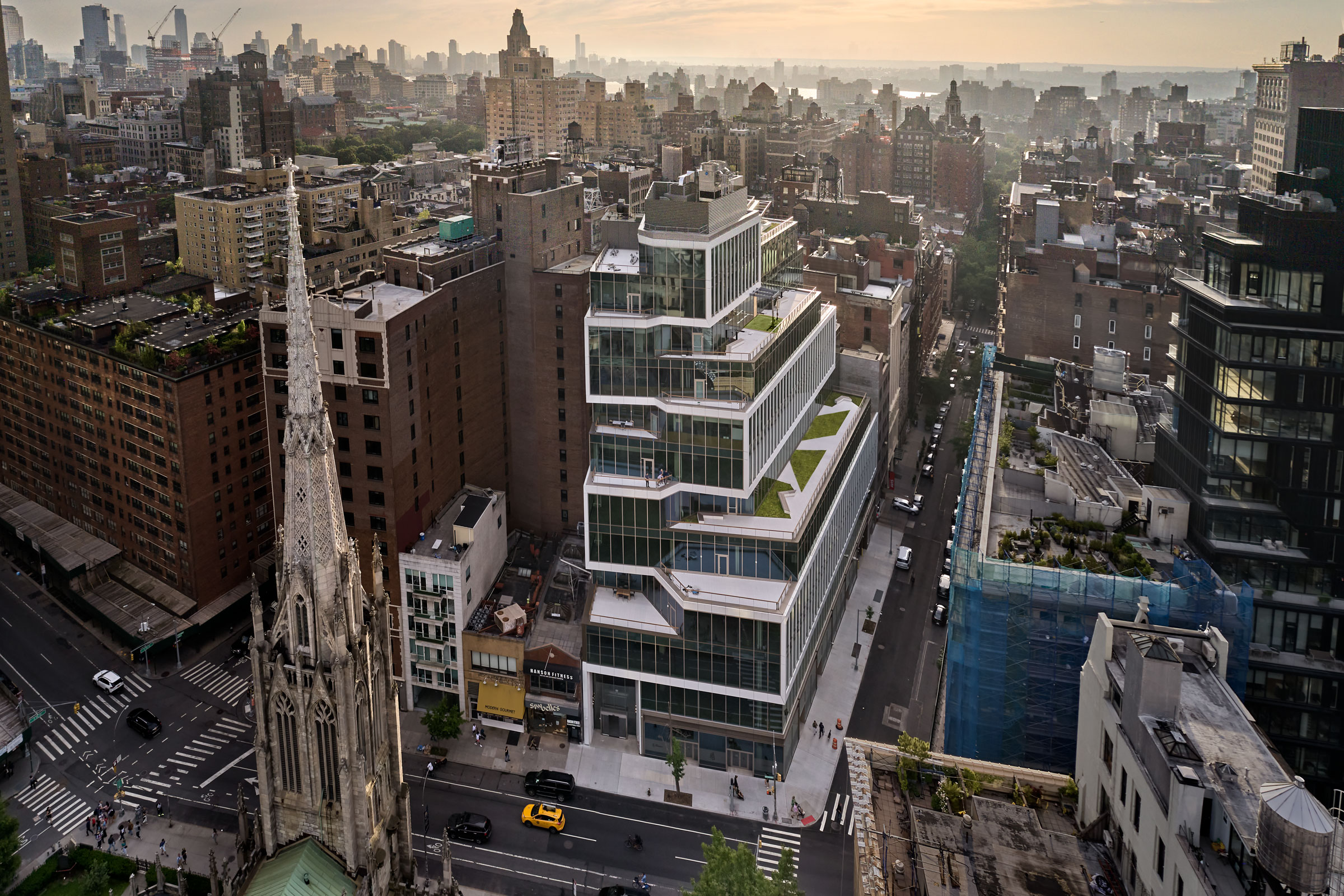
Fifteen-foot ceilings and floor-length windows at the Perkins&Will-designed 799 Broadway help bring natural light into the space, giving the interiors an open and transparent feel while lowering energy costs. Photo by Chris Cooper
In New York City’s historic mixed-use Greenwich Village, 799 Broadway is leading the charge when it comes to next-generation workspaces. Designed by Perkins&Will to LEED Gold standards, this boutique office project includes a bevy of sustainable, wellness-focused features and considerations that help it stand out from the conventional office space.
“You don’t separate design and sustainability; they are one in the same,” Robert Goodwin, design principal at Perkins&Will New York, previously told gb&d. “We always need to be considering energy efficiency, resiliency, regeneration, and occupant wellness. True sustainability requires a comprehensive approach.” And 799 Broadway’s design is nothing if not comprehensive.
Angled primarily to the east and north, the building does not require an external shading system and experiences minimal heat gain, reducing cooling tower loads by 10%. High ceilings, narrow floor plates, and an open floor plan allow the structure to rely primarily on natural light for its illumination needs, drastically reducing operational energy requirements. Natural materials like wood and stone were integrated into both the interior and exterior, while outdoor terraces grace nearly every level.
And because 799 Broadway’s design was conceived during the Coronavirus pandemic, the team at Perkins&Will placed a high level of importance on indoor air and environmental quality. The building utilizes touchless access wherever possible and includes high-efficiency MERV-8/MERV-13 air filtration systems—the latter of which incorporates bipolar ionization in order to alter the molecular protein structures of pathogens and viruses, reducing their ability to infect occupants.
In addition to achieving LEED BD+C Core & Shell Gold certification, 799 Broadway has also earned WELL Certification and boasts a Fitwel 2-star rating.
5. Old Chicago Post Office, Chicago
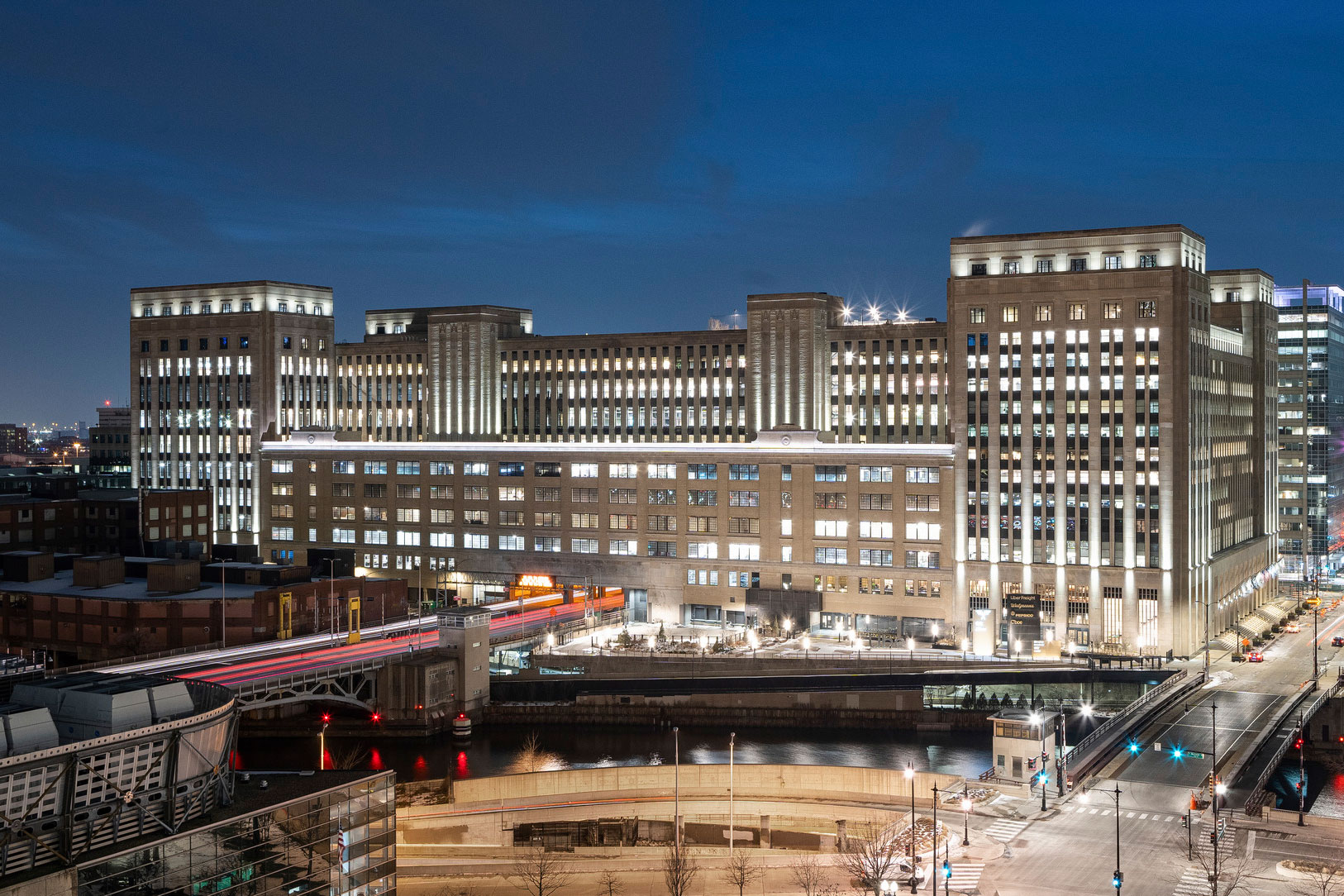
The Old Chicago Post Office sat vacant for many years before Gensler started a large restoration project. Photo by Serhii Chrucky
Once considered a lost cause, the Old Chicago Post Office is proof that the most sustainable building is the one that already exists. Originally built during the 1920s as the city’s primary post office, the 2.8-million-square-foot Art Deco behemoth shuttered its doors in the late 1990s and sat abandoned for over two decades before receiving a second chance at life.
Redesigned by Gensler, this stately example of adaptive reuse earned LEED Gold certification in 2020. Extensive work was done to restore and repair the building’s Indiana limestone cladding, with the design team collaborating with Regal Stone and Polycor to source replacement stone from local mines where necessary.
Natural stone also appears throughout the building’s interior, chosen in large part due to its timeless aesthetics, status as a VOC-free material, and low-impact extraction process. “It’s a very simple process; you just need brute strength. It’s ready-made, and it’s also recyclable. It comes from the earth, and it goes back to the earth,” Stephen DiRaffaele, LEED Green Associate and architectural sales representative of Polycor, previously told gb&d. “Unlike strip mining you’re not damaging the environment. A lot of quarries are reclaimed after their usefulness has expired and natural water fills them; they become lakes.”
Even more impressive than the project’s elegant interior, however, is the Meadow, a 3 ½ acre rooftop park that boasts everything from a bistro and bar area to a running track and basketball court nestled amidst thousands of native plantings. The restored structure now stands as a hub of business and commerce, providing event and commercial office space to high-profile tenants like Uber, Walgreens, and PepsiCo.
6. Austin Community College Highland Campus, Austin
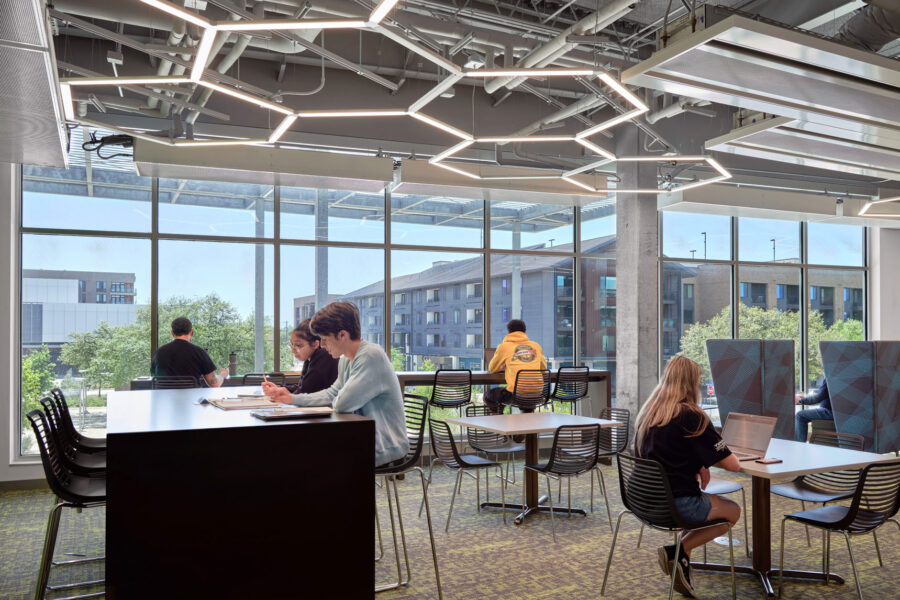
Plentiful natural light fills this collaborative learning space at Austin Community College’s Highland Campus. Photo by Dror Baldinger
As consumer habits continue to shift towards e-commerce and online shopping, physical stores—and shopping malls in particular—are becoming increasingly obsolete. But what happens to those malls once they shut their doors? In the case of Austin’s Highland Mall, they become thriving, walkable college campuses.
Originally built in 1971, the Highland Mall enjoyed an initial period of success before floundering in the early 2010s, at which point it was acquired by Austin Community College (ACC), who began renovations with the intent of expanding ACC’s campus network. The first phase was executed by Barnes Gromatzky Kosarek Architects, who continued to play a major role in the finished product years later. But there was a lot of excitement in moving the project forward, according to Gardner Vass, design principal with Perkins&Will, the firm that headed renovations during the latter phases.
“There was potential to make a huge impact within the neighborhood, becoming a center for innovative learning and bringing a renewed energy to a very important part of Austin,” Vass says. “The mall site has many advantages—being a central hub near major roadways, having several adaptive reuse building opportunities, and being close to public transportation.”
Vass has seen more developers interested in adaptive reuse, not just for the economic advantage of reusing what already exists, but also to address the issue of finite resources and development space. Repurposing materials allows developers to decrease their carbon footprint and reduce the amount of debris sent to a landfill during a project.
7. Brown Dining Hall, Cullowhee, NC
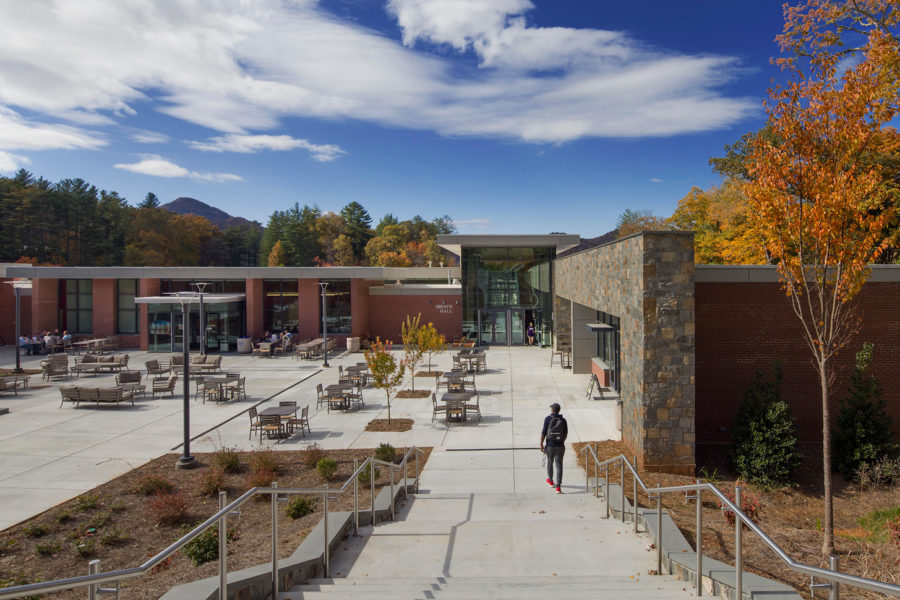
The team at McMillan Pazdan Smith Architecture was able to redevelop the brownfield site into a space that helped to reestablish the community and improve the quality of life. Photo by Gary Matson
Perched on a hillside that faces the scenic Smoky Mountains, Western Carolina University’s Brown Dining Hall was once an underutilized building that had become a storage and equipment rental space for the campus. When the team at McMillan Pazdan Smith Architecture started the renovations, they wanted to make Brown Hall central to the community while also working toward LEED Gold.
Improvements in energy efficiency were attained by switching to LED lighting and installing an HVAC system that helped to regulate the temperature of individual building zones. An overall 27.8% of energy cost savings was achieved, along with a 4% reduction in annual building energy consumption. High-efficiency water fixtures and native vegetation that didn’t require irrigation aided in a reduction of water use, and building materials like adhesives and paints were all low in VOCs.
Preserving the original building structure helped the team earn most of its LEED certification points, as they redeveloped the site into a space that helped to reestablish the community and improve the quality of life. “The 25,000-square-foot expansion was designed along a new pedestrian spine, which created a corridor between the upper and lower campus. The interior was also reoriented to reveal the spectacular mountain views, and more importantly, grant pedestrians entry into the building from either east or west. This strategy achieved the goal of introducing the spaces within the existing building to daylight,” Jana Hartenstine of McMillan Pazdan Smith previously told gb&d. In the end the team was able to successfully reuse 94% of the building’s original structural elements.
8. City of Hope Administrative Building, Duarte, CA
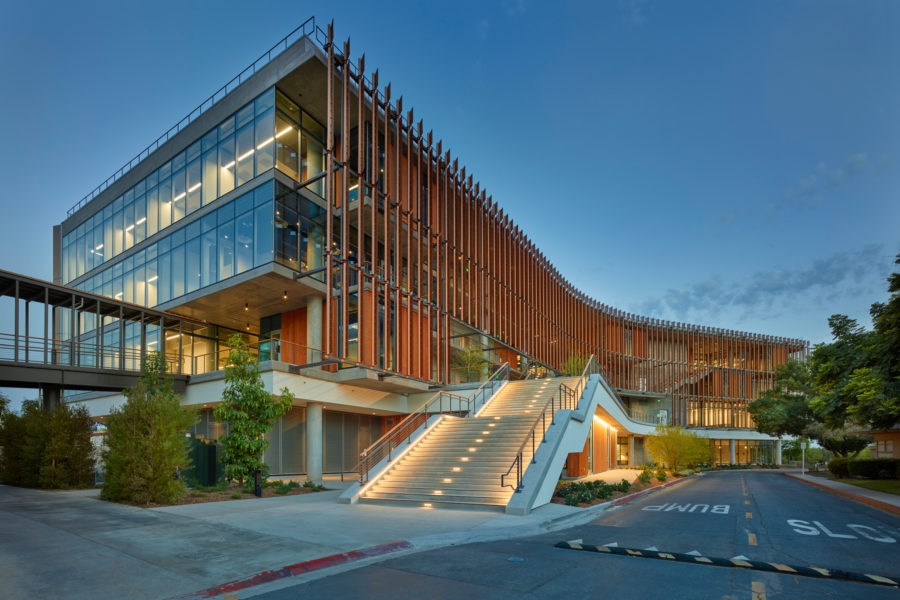
The City of Hope administrative building is a four-story, 108,000-square-foot structure with a LEED v4 Gold Certification. Photo by Benny Chan
City of Hope is a comprehensive cancer center in Duarte, California that focuses on treatment protocols and research. The main campus is currently undergoing a 20-year construction plan in an effort to meet the growing demand for treatment and research advancement. The four-story, 108,000-square-foot administrative building has already undergone its transformation, with a LEED v4 Gold certification achieved.
Reducing CO2 emissions played a major role toward the certification, with the team at Walter P Moore working closely with the concrete supplier to develop a new mixture that resulted in a 44% reduction. “The City of Hope project shows how an early, integrated, and comprehensive approach to addressing both operations and embodied carbon achieves reductions total project carbon emissions,” Dirk Kestner, principal and director of sustainable design at Walter P Moore, previously told gb&d.
By installing solar PV panels on the roof, the building was also able to generate nearly 40% of its own energy, resulting in substantial savings throughout the life of the building. A sunshade installed across floating walkways and stairs helps to protect the western face of the building from the sun, resulting in a reduced amount of insulation and saving on materials.
9. Yale Campus & Science Building, New Haven, CT
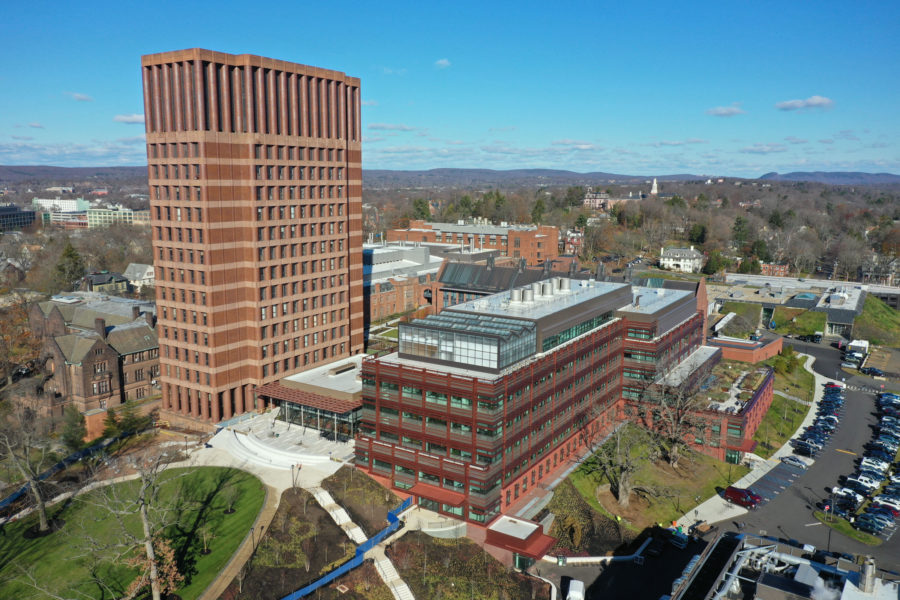
The Yale Science Building features high-performance air distribution and heat recovery. Photo by Paul Coco
Sustainable design is more than a commitment at Yale; it’s a standard. The prestigious university required that all new construction and renovation project designs made on the campus meet LEED Gold status or higher from 2010 on. Fast-forward to 2022 and 27 LEED Gold building projects have been completed, with 14 more on the way. Yale is focused on creating a better environment while improving the health of people on-campus by integrating more access to natural light and using nontoxic materials in its designs.
“We have a disclosure requirement for materials that have Red List ingredients so we can opt for those without, and our furniture standards specifically address chemicals of concern. We continue to investigate standards for healthy building materials,” Ginger Chapman, director of the office of sustainability at Yale, told gb&d in a previous article.
The Yale Science Building, which opened in 2019, received its LEED Gold certification in May 2022. The building was designed to meet LEED Gold standards with the inclusion of high-performance air distribution, heat recovery, a rooftop greenhouse, and an energy use target that cut energy consumption inn half.
10. Perkins Eastman, Pittsburgh

The team at Perkins Eastman in Pittsburgh focused on designing a smaller, more flexible workspace that eliminated barriers and reduced construction costs. Photo by Andrew Rugge
Due to the rise in remote work, the team at Perkins Eastman in Pittsburgh focused on designing a smaller, more flexible workspace that eliminated barriers, reduced construction costs, minimized waste, and allowed for better views of downtown along with a variety of free-address seating that gives people the freedom to move and work about the office as they see fit.
Reducing the space’s carbon footprint was also a major focus of the project. “A recent study by the Carbon Leadership Forum identified the large cumulative impact of embodied carbon generated from a typical five- to 15-year interior fit-out and renovation cycle,” said Jennifer Askey, associate principal at Perkins Eastman, in a previous gb&d article. “With this in mind, our team took a deep dive into the impact our reductionist approach had on our studio fit-out’s carbon footprint.” Using previous projects as a benchmark, they were able to reduce their carbon footprint by nearly 35%.
Through designing a more flexible, smaller space, and incorporating healthy materials with low carbon emissions as well as low VOCs, the team at Perkins Eastman was able to claim a LEED Gold certification.
11. Engineering Innovation Hub, New Paltz, NY![]()
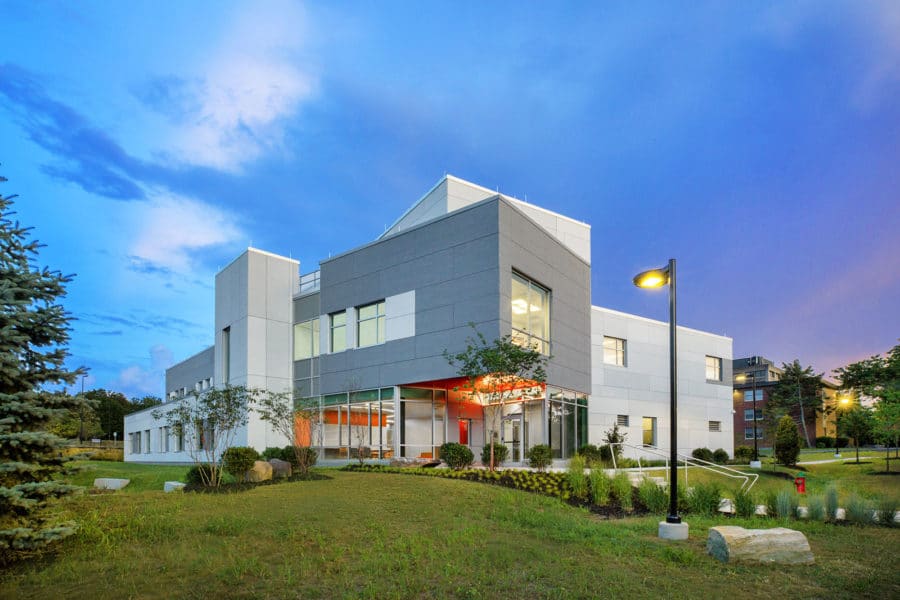
The new LEED Gold–certified Engineering Innovation Hub (EIH) building at the State University of New York (SUNY) at New Paltz was designed by Urbahn Architects. Photo by Leon Hordijk
The State University of New York at New Paltz is a highly selective college of about 8,000 undergraduate and graduate students about 90 minutes outside of New York City. There, engineering students and researchers work on 3D design and 3D printing inside the new Engineering Innovation Hub, which itself is certified LEED Gold.
Built on a former parking lot, the site eliminated the need for excavation, which can often be costly. Landscaped bioswales were planted to help direct rainwater into a retention pond that would further aid keeping moisture from entering into places it shouldn’t be. The roof is made of a white reflective thermoplastic polyolefin membrane system, which helps to reduce the heat island effect.
High efficiency LED fixtures were installed along with light sensors to help conserve energy, and an emphasis on maximizing daylighting further reduced energy consumption. “Window headers are nine feet above the floor so light can penetrate deep into interior spaces. Our team analyzed several glazing options to maximize the energy efficiency of the exterior walls and ultimately designed window assemblies using double glazed low-E glass that provide ideal comfort levels, daylighting, and views while utilizing less than 30% of the exterior wall surface,” Urbahn Architects’ Project Manager Arielle Siegel Lapp said in a press release.
12. Fairview Heights, Inglewood, CA
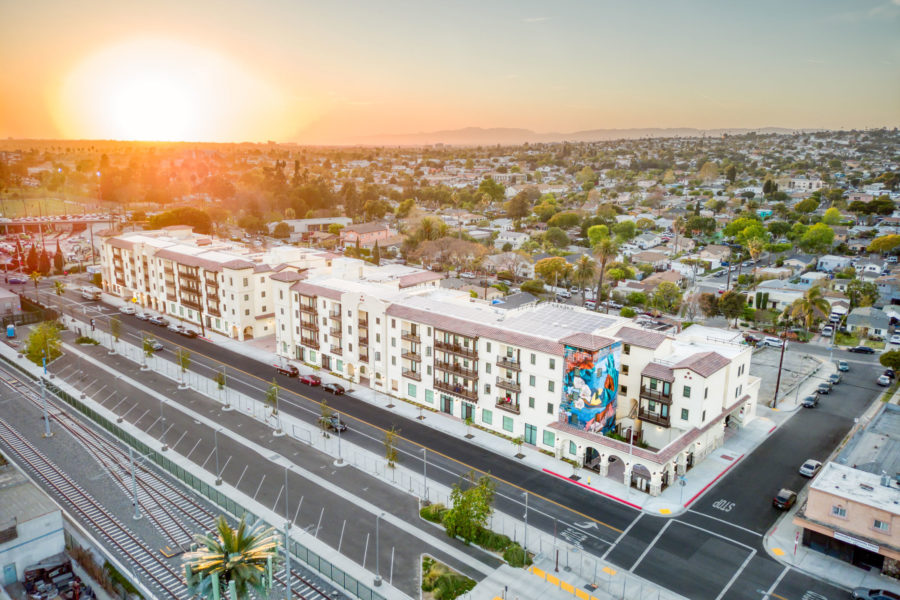
Fairview Heights in Inglewood, California, was designed by KFA. Photo by ArchLenz Photography
KFA is a diverse, forward-thinking architecture firm in Los Angeles that has designed and built more than 6,000 affordable housing units since 1988. When they were approached to turn an obsolete building property at the intersection of Long Avenue and Redondo Boulevard into affordable housing, they set a goal to make Fairview Heights a sustainable, healthy environment that would act as a beacon of hope for the community.
One of the most impressive features of Fairview Heights is its substantial solar panel array on the roof. “The robust photovoltaic system was designed to generate enough onsite electricity to support the nearly 14,000 square feet of common space, which includes a large community room with a teaching kitchen, a computer lab, case management and resident service offices, and conference rooms,” John Arnold, partner at KFA Architecture in Culver City, wrote in a previous article for gb&d.
The landscape design also helped in earning LEED points for the project, as a minimum of 75% of the plant selections had to be drought-tolerant, ensuring the outside play areas could survive the arid conditions that climate change has brought. Fairview Heights was built with a LEED Gold certification in mind, and it became official in March 2022.
13. citizenM, Seattle
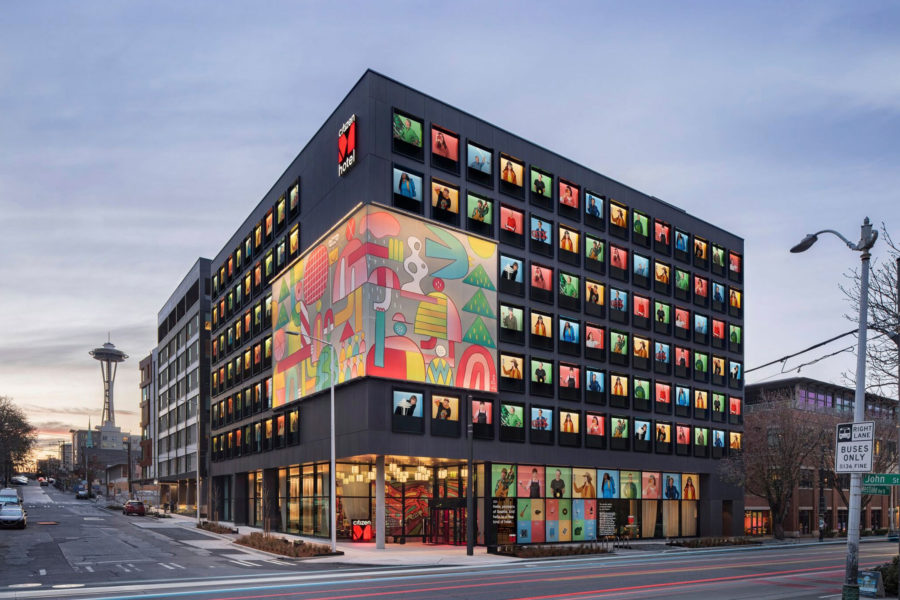
Gensler designed the new citizenM hotel to blend in with its trendy Seattle neighborhood. Photo by Richard Powers
citizenM hotel is nicely positioned in Seattle’s downtown so prominent tourist locations like Lake Union, the Space Needle, and the Chihuly Garden & Glass exhibit are only a short walk away. Seattle’s first ever fully modular hotel was designed by Gensler to meet LEED Gold.
Modular designed buildings are already ahead of the game when it comes to waste management and emissions savings. Each of these 264 units was prefabricated in a factory. citizenM’s model made modular building even simpler, though, as the hotel chain offers one type of room—a single, king-sized bedroom—and an accessible iteration. Manufacturing the units in a factory setting has a myriad of benefits from an environmental perspective; where the average building will involve shipping more materials than needed to any given site, the excess of which will need to be disposed of, a factory is able to aggregate materials and distribute them between projects as well as plan out what’s needed precisely, so waste is minimized.
The building also boasts an array of solar panels on its roof as well as a heat pump. This has resulted in a building that uses 29% less energy than otherwise.
14. Rancho Los Amigos Recuperative Care Campus, Downey, CA
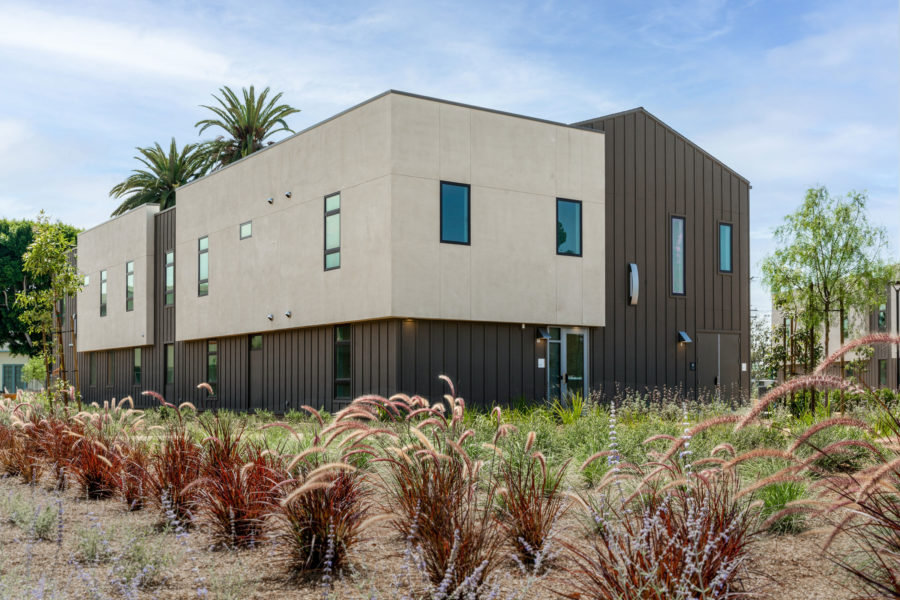
The 6.8-acre campus is designed around the landscape, and the drought tolerant native plants help to restore the natural habitat. Photo by Ric Berryman
The Rancho Los Amigos Recuperative Care Campus designed by GGA+ sets the standard for rehabilitation care in Los Angeles County by helping individuals who have experienced physical trauma to heal and move forward through therapeutic care and permanent supportive housing. The 6.8-acre campus is designed around the landscape in order to promote a strong sense of community while using nature as a healing tool.
“Conceptually the GGA+ team referenced a farming village as a site planning prototype appropriate to the history and culture of the campus,” Staci Nesbitt, principal architect at GGA+, wrote in a previous gb&d article. “Respecting the rich context of existing mature trees at the site, the proposed plan created an informal and organic organization of the buildings and associated outdoor spaces.”
The native plants are drought tolerant and help to restore the natural habitat, while connective decomposed granite pathways provide an organic framework for healing the environment. The paved areas that are used for staff and visitor parking were built using a cool-coated asphalt in order to combat the heat island effect. A gray water irrigation system was also installed.
Other new site infrastructures include water, gas, sewer, and a stormwater retention and filtration system. Photovoltaic panels are utilized for onsite renewable energy production, and energy-efficient insulation helps to maintain a comfortable climate for the patients. The project received LEED Gold certification in September 2022.
15. The Sciences Building, Dallas
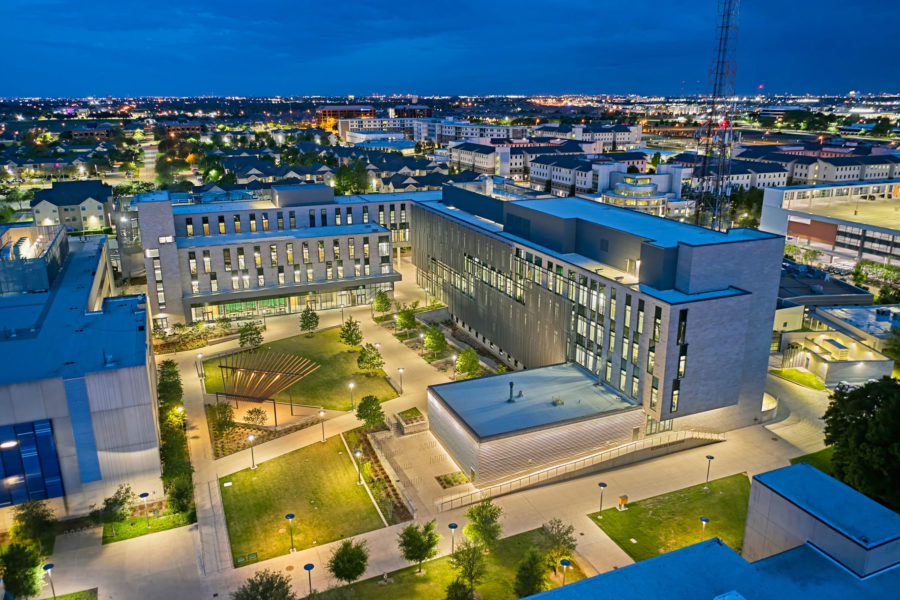
A bioswale collects rainwater from the roof to water plants. It also allows natural light into the lower level. Photo courtesy of Stantec
The Sciences Building at the University of Texas at Dallas acts as a classroom, research building, and space for students to connect. Predominantly housing the physics department, the building contains classrooms, offices, and laboratories that require a high demand of resources and a delicate space to perform research. The team at Stantec was able to achieve LEED Gold for the 186,000-square-foot building.
When it came to designing a building for intensive research, demands in energy were on the forefront. High-efficiency HVAC equipment, LED lighting, and a high-performance envelope were utilized, resulting in an estimated 26.6% energy savings. About 75% of construction waste was diverted from the landfill, and the team at Stantec worked to limit pollution into a nearby creek by directing the flow of water away from heaving traffic to make sure it can filter out. Low flow equipment was installed to help save on water and a bioswale was designed to harvest rainwater.
An impressive 40% of the building’s materials were able to be sourced locally in order to reduce CO2 emissions from lengthy shipments. “We were very intentional about finding as much as we could locally. It’s good for LEED points, but it just makes good sense,” Amy Holzle, a principal at Stantec and project manager for the building, previously told gb&d. “The campus is a huge part of the Dallas-Fort Worth community, so it’s important that we also support the community. And by sourcing local products we didn’t have to get a lot of stuff from some thousands of miles away.”
Matt Noel and Laura Rote contributed to this article.

